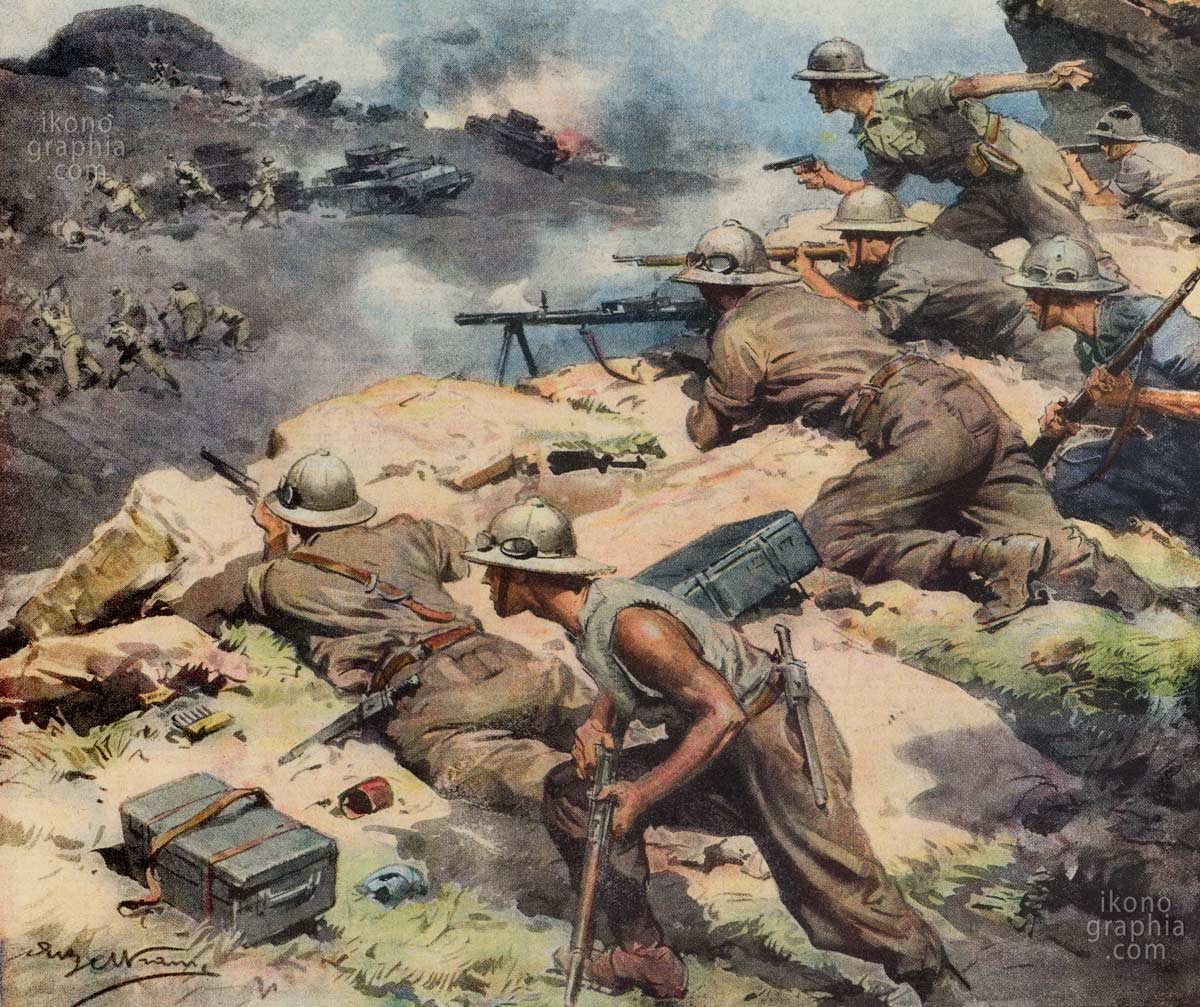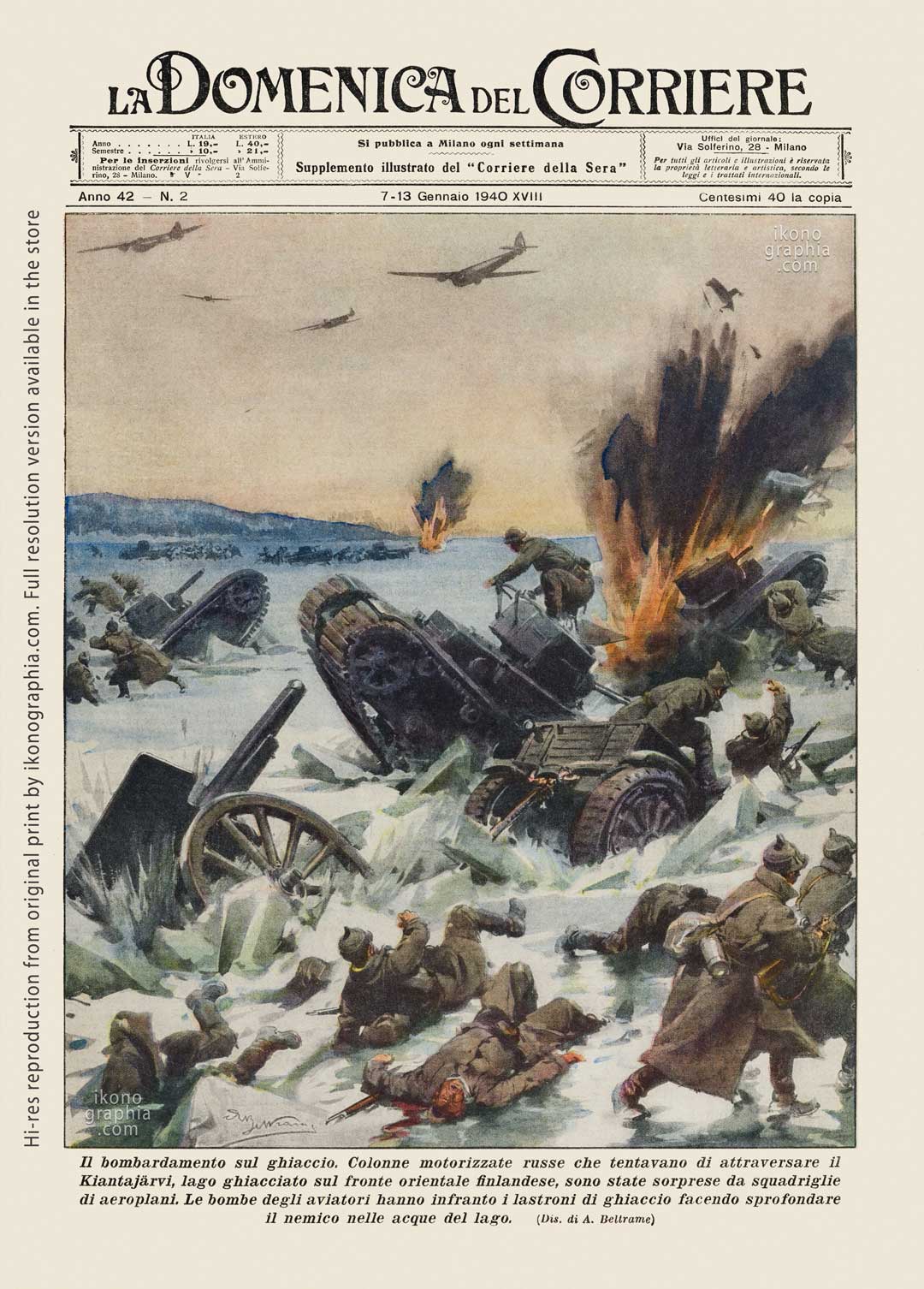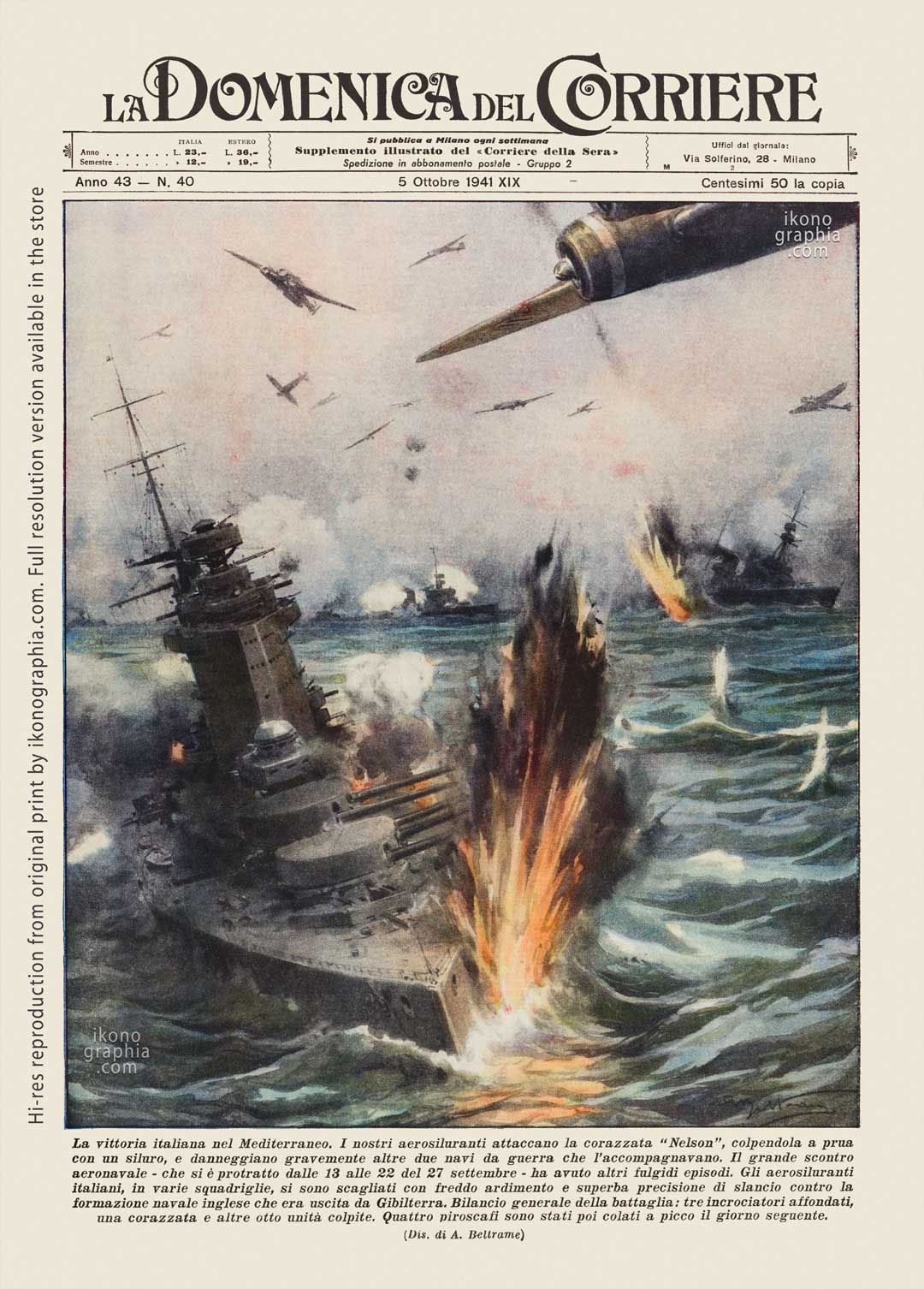WWII according to Fascist Propaganda in Achille Beltrame’s Drawings

Achille’s Beltrame war plates for “La Domenica del Corriere” 1939-1942
Like all media controlled by strict censorship, the magazine “La Domenica del Corriere” reflected the Fascist Party’s view of the war, like a good vs. bad fight, enhancing Axis victories. In some cases, they were absolutely fake-news; in other cases, they told a sort of “Alternative Truth.”
Achille Beltrame was an Italian painter and illustrator. His color plates for “La Domenica del Corriere,” the most popular Italian periodical, became the magazine’s hallmark. They cover the whole history of Italian customs and society of the first half of the 20th century, masterfully summarizing news, sports, and war.
Beltrame made them alive and current in the eyes of a population not yet completely out of illiteracy. He never moved from Milan, where he designed all his tables. Nevertheless, he managed to represent places, facts, people, and things he had never seen in person, thanks to his innate imagination and curiosity, combined with a rigorous sense of realism. The graphic composition of his works is still a reference.
From 1899 to 1945, he drew for the magazine 4,662 front and back covers. Below a selection in chronological order.
Leggi in italiano
Illustrazioni di Achille Beltrame sulla seconda guerra mondiale per ”La Domenica del Corriere” 1939-1942.
Come tutte le pubblicazioni italiane, sottoposte a stretta censura, anche la “Domenica” rifletteva il punto di vista del Partito Nazional Fascista, di una sorta di lotta del bene contro il male. Le vittorie dell’asse venivano enfatizzate a dismisura. Le notizie dal fronte erano spesso delle “fake-news” o per lo meno davano una “versione alternativa” della realtà.
Fanno eccezione le tavole sulla guerra in Africa del Nord o alcune battaglie nel Mediterraneo, dove gli italiani si batterono valorosamente e dettero molto filo da torcere agli inglesi.
Le tavole di Beltrame per la “Domenica del Corriere”, divennero fiore all’occhiello e marchio di fabbrica della rivista raccontando magistralmente notizie, costume, sport e guerra nella prima metà del 1900.
Le copertine di Beltrame erano vive e comprensibili ad una popolazione non ancora completamente uscita dall’analfabetismo. Nonostante non si fosse mai mosso da Milano, fu in grado di raccontare in modo preciso e realistico, fatti, persone e luoghi che non aveva mai visto di persona, grazie alla sua immaginazione, curiosità e realismo. La composizione grafica delle tavole è tuttora una riferimento di livello assoluto.
Dal 1899 al 1945, Beltrame disegnò per la rivista 4662 copertine e retro copertine. Qui sotto una selezione in ordine cronologico.
December 3, 1939.
Mines War.
Every day, in the North Sea and around England, belligerent or neutral, merchants or warships collide with the numerous mines that infest all routes. A terrible explosion shakes the steamer that has come into contact with the dangerous device, debris flying in every direction, the ship overturns wounded… And in a short time, the sea swallows a new victim.
Original Italian copy.
La guerra delle mine. Ogni giorno, nel Mare del Nord e attorno all’Inghilterra, navi belligeranti o neutrali, mercantili o da guerra urtano contro le numerosissime mine che infestano tutte le rotte. Un tremendo scoppio squassa il piroscafo che è venuto a contatto col pericolosissimo ordigno, rottami volano in ogni direzione, la nave si rovescia ferita… E in poco tempo il mare inghiotte una nuova vittima.
December 3, 1939
Cheering in the shadow of the guns.
Taking advantage of the calm that reigns on the front, the gunners of a German anti-aircraft battery organize cheerful football matches behind the Siegfried line. The fellow soldiers, all around, cheer the players on joyfully.
Original Italian copy.
Il “tifo” all’ombra dei cannoni. Approfittando della calma che regna sul fronte, gli artiglieri di una batteria antiaerea tedesca organizzano, dietro la linea di Sigfrido, allegre partite di calcio. I commilitoni, tutt’intorno, incitano i giocatori festosamente.
January 7, 1940.
Bombing the Reds on the ice.
Russian motorized columns attempting to cross the Kiantajärvi, a frozen lake on the Finnish eastern front, were surprised by airplanes’ squadrons. The aviators’ bombs broke the ice sheets causing the enemy to sink into the waters of the lake.
Original Italian copy.
Il bombardamento sul ghiaccio. Colonne motorizzate russe che tentavano di attraversare il Kiantajärvi, lago ghiacciato nel fronte orientale finlandese sono state sorprese da squadriglie di aeroplani. Le bombe degli aviatori hanno infranto i lastroni di ghiaccio facendo sprofondare il nemico nelle acque del lago.
March 10, 1940.
The war on the Indian Sea.
An English steamship with a crew of 150 Indians was attacked by a German aircraft and fatally hit by three bombs. The ship caught fire.
Original Italian copy.
La guerra sul mare. Un piroscafo inglese sul quale viaggiavano 150 indiani è stato attaccato da un aeroplano tedesco e colpito in pieno da tre bombe. La nave si è incendiata.
May 5, 1940.
The fight in Norway.
Among the deep gorges of the Gudbrand valley, German columns are advancing fighting towards Trondhjem.
Original Italian copy.
La lotta in Norvegia. Fra le gole profonde della vallata di Gudbrand colonne tedesche avanzano combattendo verso Trondhjem.
January 12, 1941
The devastated central London with the surviving St Paul’s Cathedral.
Among the ruins of the “City”. After the German bombing, British soldiers and firefighters complete the destruction of central London, blowing up the walls still standing and crumbling with dynamite. In the background, St. Paul’s Cathedral, which has remained intact in the midst of so much decay.
Original Italian copy.
Tra le rovine della “City”. Dopo i bombardamenti tedeschi, soldati inglesi e vigili del fuoco, completano la distruzione del centro di Londra, facendo saltare con la dinamite le mura rimaste ancora in piedi e pericolanti. Sullo sfondo, la cattedrale di San Paolo, rimasta intatta in mezzo a tanto sfacelo.
July 13, 1941.
Germans greeted as liberators.
The moment of liberation. In the prison of a city taken to the Soviets, German soldiers are greeted with enthusiasm and emotion by hundreds of political prisoners, including older men and women, who greet them as liberators and beg for bread.
Original Italian copy.
Il momento della liberazione. Nella prigione di una città strappata ai sovietici, i soldati tedeschi vengono accolti con entusiasmo e commozione da centinaia di detenuti politici, vecchi e donne compresi, che li salutano come libertori e implorano un pò di pane.
July 13, 1941.
Italian infantry against British troops in North Africa.
The fierce Italian resistance in the Gondar area. Clinging to the ground, taking advantage of every possibility of defense, our heroic soldiers repel violent enemy attacks with indomitable courage.
Original Italian copy.
La fiera resistenza italiana nella zona di Gondar. Aggrappati al terreno, sfruttando ogni possibilità di difesa, i nostri eroici soldati respingono con indomabile ardimento i violenti attacchi nemici.
August 17, 1941.
Italians push-off the British attacks to keep Tobruk.
Alarm in the desert. One of the almost daily British attempts to break the iron circle around Tobruk: while the desert wind rages, enemy tanks and airplanes try to get closer to our positions; but the move is warned, and the batteries open fire on the opponent, forcing him to retreat once again.
Original Italian copy.
Allarme nel deserto. Uno dei quasi quotidiani tentativi inglesi di rompere la ferrea cerchia intorno a Tobruk: mentre infuria il vento del deserto, carri armati e aereoplani nemici cercano di avvicinarsi alle nostre posizioni; ma la mossa è avvertita e le batterie aprono il fuoco contro l’avversario, costringendolo ancora una volta a ritirarsi.
The United States in Fascist Propaganda.
According to the Italian press, in the early years of war, the United States was an exhausted country that had not yet recovered from the effects of the Great Depression of 1930s.. Mussolini believed that a possible entry of the United States into the war would have been irrelevant since the American production capacity in the war sector was behind.
Even after the Japanese attack on Pearl Harbor and the subsequent declaration of war, the hypothesis of real US involvement in the conflict in the European and Mediterranean theater was considered unlikely.
Leggi in italiano
L’immagine degli Americani e dell’America nella propaganda italiana di guerra.
Gli Stati Uniti, per la stampa italiana dei primi anni del conflitto, erano un paese allo stremo non ancora risollevatosi dagli effetti della Grande Depressione degli anni ‘30. È nota la convinzione mussoliniana secondo la quale una eventuale entrata in guerra degli Stati Uniti sarebbe stata assolutamente ininfluente in quanto la capacità produttiva americana nel settore bellico era praticamente irrilevante.
Anche dopo l’attacco giapponese a Pearl Harbour e la successiva dichiarazione di guerra agli Usa, l’ipotesi di un reale coinvolgimento degli Stati Uniti nel conflitto nel teatro di operazioni europeo e sul Mediterraneo era considerata come improbabile. Fonte
La vittoria italiana nel Mediterraneo. Original Italian Copy
La vittoria italiana nel Mediterraneo. I nostri aerosiluranti attaccano la corazzata “Nelson”, colpendola a prua con un siluro, e danneggiando gravemente altre due navi da guerra che l’accompagnavano.
Il grande scontro aeronavale – che si è protatto dalle 13 alle 22 del 27 settembre – ha avuto altri fulgidi episodi. Gli aerosiluranti italiani, in varie squadriglie, si sono scagliati con freddo ardimento e superba precisione di slancio contro la formazione navale inglese che era uscita da Gibilterra.
Bilancio generale della battaglia: tre incrociatori affondati più una corazzata e altre otto unità colpite. Quattro piroscafi sono stati poi colati a picco il giorno seguente.
October 10, 1941.
The Italian victory in the Mediterranean.
Our torpedo bombers attacked the battleship “Nelson,” hitting it in the bow with a torpedo and severely damaging two other escort warships. The great air-naval clash lasted from 1 to 10 PM on September 27 and had other shining episodes. The Italian torpedo bombers, in various squadrons, hurled themselves with cold courage and superb precision against the English naval formation that had left Gibraltar. Overall battle balance: three sunken cruisers, one battleship, and eight other units hit. Four steamers were then sunk the following day.
Read the original Italian copy in the tabbed content below
November 30, 1941.
Firestorm on the British columns.
Axis aircraft squadrons swoop down on the British motorized columns attacking in Marmarica and heavily bombarding, smashing many wagons, and pinning others to the ground.
Original Italian copy.
Tempesta di fuoco. Squadre di aeroplani dell’Asse piombano in picchiata sulle colonne motorizzate inglesi che attaccano nella Marmarica e le tempestano di bombe fracassando molti carri e inchiodandone altri al terreno.
December 28, 1941.
The commander at the periscope. The enemy in sight!
Inside one of our submarines immersed, among the thousand complicated devices of the very modern ship, the commander scrutinizes the opponent’s moves, waiting to transmit the orders to the crew.
Original Italian copy.
Nemico in vista! Nell’interno di un nostro sommergibile immerso, tra i mille complicati congegni della modernissima nave, il comandante scruta le mosse dell’avversario, in attesa di trasmettere gli ordini all’equipaggio.
April 5, 1942.
An Italian submarine sinking an American tanker.
Italian submarines in American waters. The last moments of an enemy tanker hit with a torpedo and then with cannon fire.
Original Italian copy.
I sommergibili italiani nelle acque americane. Gli ultimi istanti di una petroliera nemica colpita con un siluro e poi a cannonate.
May 3, 1942
Axis airplanes devasting Malta.
Malta under the storm of bombs. The armor-piercing shells and two-thousand-kilo bombs, thrown by Axis airplanes on the fortifications of Malta during their relentless offensive, also led to the destruction of the English’s underground deposit base. “Malta” – said an eyewitness – “is a hell of ruins”…
Original Italian copy.
Malta sotto la tempesta di bombe. I proiettili perforanti e le bombe da duemila chili, gettati dagli aeroplani dell’Asse sulle fortificazioni di Malta durante la loro implacabile offensiva, hanno portato alla distruzione anche dei depositi sotterranei della base inglese. “Malta” – ha detto un testimone oculare – “è un inferno di rovine”.
1942, March 8
Artwork by Walter Molino, Beltrame’s most talented pupil. He drew some covers since 1941 and then became the exclusive creator for almost thirty years
Kamikaze
“Taiatari,” which means the body’s impact, is the Japanese system of the suicide attack. The airplane throws itself at the target with its deadly load of bombs, guided by the pilot, who sacrifices himself but hits infallibly. With the “Taiatari,” the North American aircraft carrier “Yorktown” was attacked: the bomber crashed in the middle of the aircraft lined up on the bridge, burning and destroying everything.
Original Italian copy.
“Taiatari”, cioè l’urto del corpo, è il sistema giapponese di attacco in picchiata. L’aeroplano si getta sull’obbiettivo col suo mortale carico di bombe: precipita guidato dal pilota, che si sacrifica ma colpisce in maniera infallibile. Col “Taiatari” è stata assalita la portaerei nord-americana “Yorktown: il bombardiere s’è abbattuto in mezzo ai velivoli allineati sul ponte incendiando e distruggendo tutto.
1941, July 13.
Artwork by Walter Molino.
Sublime heroism.
A correspondence from North Africa reports that a sergeant of the Bersaglieri, mutilated in the arm by the explosion of a grenade, took the limb and threw it at an advancing enemy tank.
Original Italian copy.
Eroismo sublime. Una corrispondenza dall’Africa Settentrionale segnala che un sergente dei bersaglieri, mutilato di un braccio per lo scoppio di una granata, ha preso l’arto e lo ha scagliato contro un carro armato nemico che avanzava.
Links , copyright and credits
Links:
Wikipedia English
Wikipedia Italiano
Il “nemico” nella propaganda fascista
Politiche di propaganda nell’Italia Fascista
L’occhio del regime sulla Grande guerra: l’Istituto Luce tra informazione, memoria e propaganda
L’immagine dei nemici. L’America e gli Americani nella propaganda italiana della Seconda guerra mondiale
Rights Advisory: “Corriere della Sera” Plates.
No known restrictions on publication.
Achille Beltrame artworks
No known restrictions on publication.
Walter Molino artworks
Ikonographia believes that this item is in the public domain under the laws of the United States, but did not make a determination as to its copyright status under the copyright laws of other countries. This item may not be in the public domain under the laws of other countries.
















